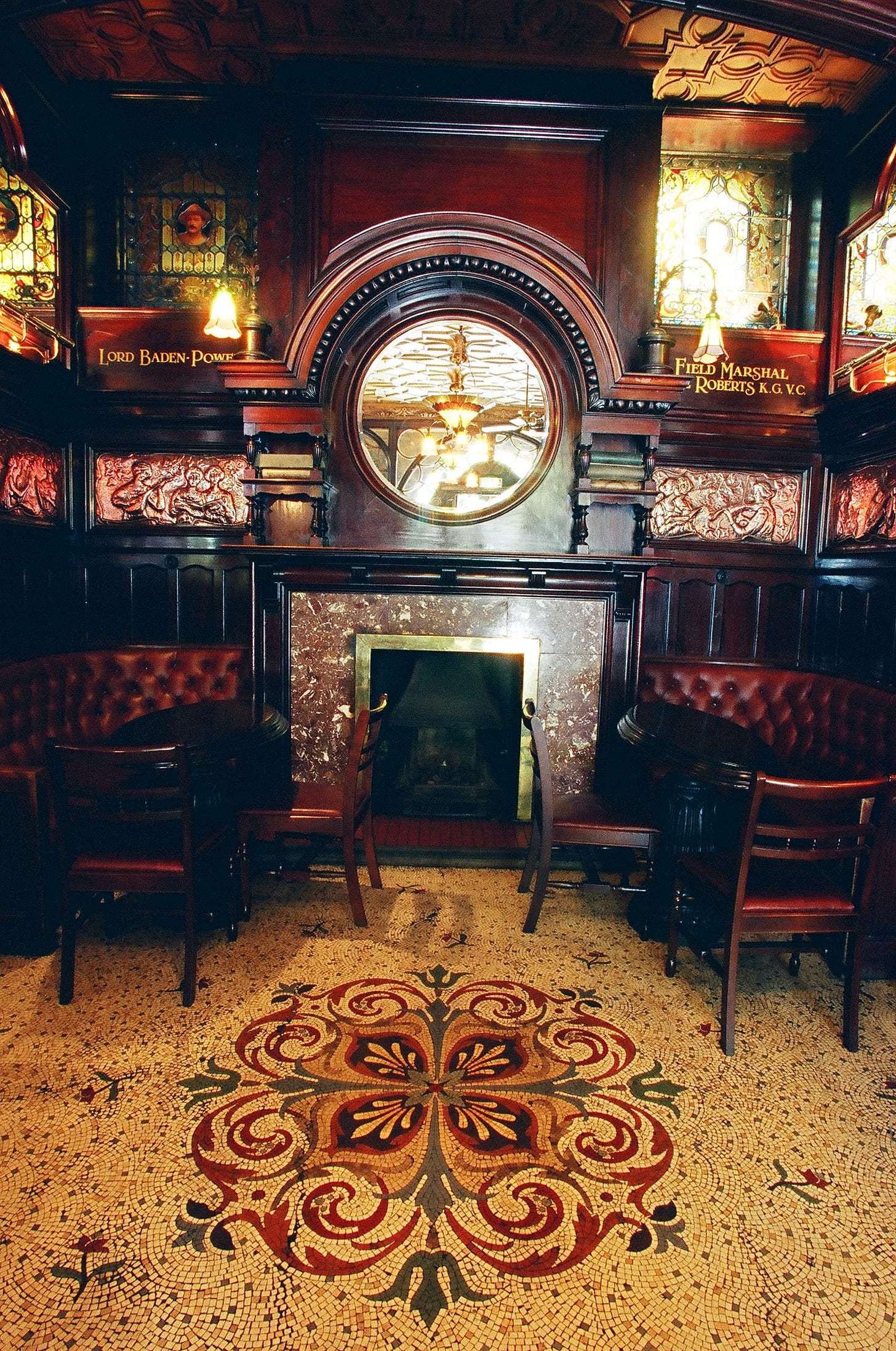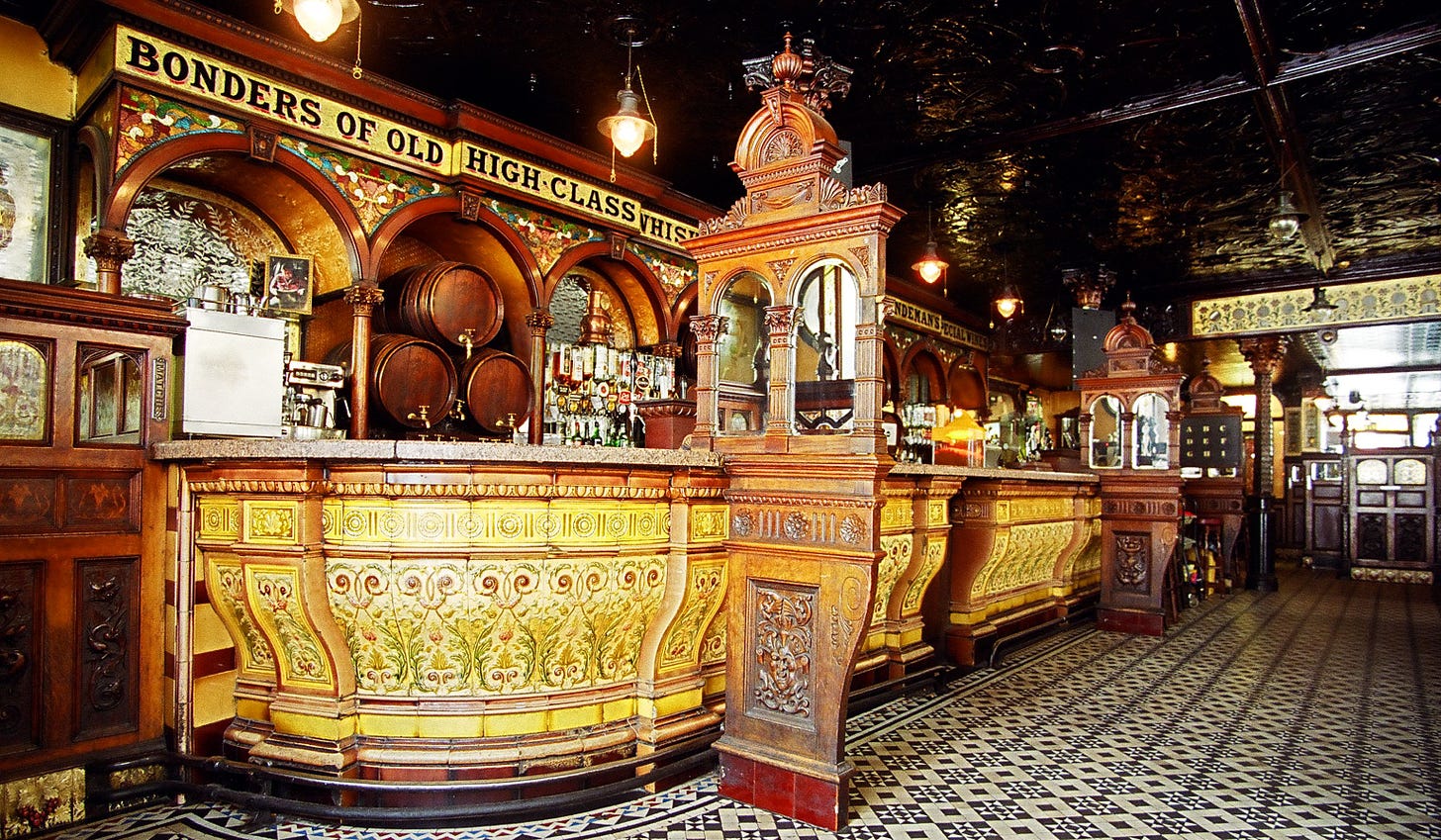More Is More – The Gin Palace
More is more rather than minimalism is my preference for interior design hence gin palaces being my favourite style of pub. If pub design were film actors, gin palaces would be the leading lady. Gin palaces evolved in the UK as a response to the huge growth of pubs that resulted from the 1830 Beer Act. At the time gin, which was cheaper than beer, was the scourge of society, addicting countless people in the underclass of London, Liverpool, and large port cities. The Beer Act permitted anyone to open a beer house on payment of a token fee with the intention for beer prices to drop below those of gin so people would turn away from the juniper spirit to the more benign brew. It did not work because gin had a better return on investment for speed of intoxication. With an abundance of licensed premises for drinkers to choose from canny entrepreneurs started building what became known as gin palaces as a way of enticing customers to pick their beautiful venues over seedy drinking dens.
Gin palaces suited their sobriquet. They were ostentatious, opulently furnished, luxuriously decorated and often situated on high footfall street corners near slum areas. The intention was to attract people who wanted to escape from their abysmal circumstances and be transported to a fantasy world, if only for the time it took to knock back a glass of Madam Geneva. No expense was spared on the décor of marble columns, mosaics, majolica tiles, glazed plate glass windows, brass fittings, illuminated clocks, and gas lighting. They had few or no chairs and tables, just the occasional hard bench to rest on because licensees wanted a fast turnover of customers and no loitering.
Different Classes Drinking In The Same Pub
At first gin palaces were one-room establishments, but soon partitioned spaces became the norm, grouped round a central bar island. This meant that people of different classes could drink in the same pub but not be seen by each other as snob-screens, frosted glass and separate entrances offered privacy. Elaborate woodwork, moulded walls and ceilings, pillars, and ceramics became a hallmark of this type of pub and outside, imposing Renaissance or Baroque façades, or whatever grand architectural statement that could be dreamt up, proved irresistible.
Today, from the hundreds of gin palaces that existed in the 19th century, there are now a handful of survivors, and they no longer just sell gin, but rather a whole range of pub drinks and food. There are also many extant pubs that were not original gin palaces but were built later in the 19th century employing the same magnificent design motifs. Those pubs reflected the wealth and imperial stature of Britain at the time.
Three of my favourite gin-palace style pubs are in the capital cities of England, Scotland, and Northern Ireland. All three were threatened by demolition in previous decades but now they have heritage listings which will protect them for posterity. They focus on cask conditioned ale and quality food and are magnets for tourists and for people who like to be entertained by their surroundings as they socialise.
The Blackfriar, London
The Blackfriar, London. Not An Original Gin Palace But Has Extravagant Design Motifs Typical Of A Gin Palace. Photo credit: Helen Peyton.
Even from outside the Black Friar looks like no other building, a tall narrow triangular structure marooned between busy roads and a railway bridge. Above one door, the statue of a black friar stands sentinel and a mosaic depicting his fellow brothers carrying fish above another entrance are visual clues to the history of the site – a Dominican Monastery was situated there from the 13th century until 1538 when it was destroyed during the Dissolution of the Monasteries. That order of monks wore black robes, hence the nickname.
Elaborate Mosaics, Copper Plaques And Bas-Reliefs Of Jolly Monks
There are four entrances into this small pub and for an unforgettable first impression of the interior enter through the rear side door. Light filters through a wall of small paned windows and stained-glass panels (one of them depicts a bald pointy eared monk who resembles Yoda) that during the day give it an ecclesiastical feel and reveals green, red, brown and yellow marble walls, elaborate mosaics, copper plaques and bas-reliefs of fat, jolly monks. Above the bar a beaten copper frieze represents friars collecting fish and in another one they gather fruit, while over the fireplace the frieze depicts brothers singing and playing musical instruments. Walk through the archway in a corner to be greeted by a marble lined room with a barrel-vaulted ceiling covered in intricately patterned golden hued mosaics. Atop four columns sit black marble devils, each carrying out a cultural pastime – painting, acting, reading, accordion playing. The whole edifice is remarkable and with the cartoon-like monks and devils having fun, it is the boozer that Walt Disney might have designed had he been in the pub business.
Café Royal, Edinburgh
Café Royal, Edinburgh. Not An Original Gin Palace But Has Extravagant Design Motifs Typical Of A Gin Palace. Photo credit: Helen Peyton.
With its sophisticated surroundings Cole Porter would undoubtedly have described the Café Royal as ‘swellegant’. The Circle Bar is a large, uncluttered room with crescent shaped booths that offer customers a largely unrestricted panorama. A central island bar has a mahogany gantry and several Olympic torch-style lamps on top of brass fluted Corinthian columns that emerge from the highly polished counter.
One wall is resplendent with a series of irreplaceable Doulton Lambeth faience panels that depict inventors and scientists such as William Caxton, Benjamin Franklin, Louis Daguerre, and Michael Faraday.
Strapping Men (In Stained Glass)
Behind a carved walnut screen with bevelled mirrors, is the Oyster Bar, an elegant wood-panelled restaurant with its own display of art in the handsome stained-glass windows that depict strapping men playing popular sports – tennis, rugby, fishing and others.
Nowadays this treasure is protected by a Grade A heritage listing but in the 1960s retail chain FW Woolworth attempted to buy and demolish the property to provide access for their adjacent Princes Street store. Thankfully the plans were rejected and the Café Royal is in its 3rd century as an Edinburgh institution, whilst Woolworth’s has ceased trading.
Belfast’s Crown Liquor Saloon
Crown Liquor Saloon, Belfast. Has Extravagant Design Motifs Typical Of A Gin Palace. Photo credit: Helen Peyton.
In a beauty pageant of gin palaces, the Crown Liquor Saloon is Queen. Masterpiece is an over-used word but for this pub it is accurate – a one-of-a-kind watering hole with Grade A heritage listing owned by the National Trust. Its façade is covered by polychromatic ceramic tiles and decorated by classical columns and pilasters, portholes and stained-glass windows. Step over the mosaic entry floor and into another era with original gaslights and ten snugs or drinking boxes - carved wood and painted glass units that screen drinkers from prying eyes.
Pineapples To Symbolize Hospitality
The room is dominated by a long red granite topped bar servery faced with yellow ceramic patterned tiles and divided by mahogany mirrored screens. Behind the bar a hardwood cabinet decorated by coloured mosaic contains huge wooden casks with polished brass taps. The ceiling is yellow, gold and red plasterwork and supported by carved wooden columns with Corinthian capitals. Stained glass windows are works of art and interior glass is etched with shells, fleur de lys, fairies and pineapples to symbolize hospitality. Like the Blackfriar, the Crown Liquor Saloon is operated by Nicholson’s Pubs so I would be very happy escaping from the world and moving in permanently so I could work my way through the cask conditioned ale selection matched with the Irish Stew or Sausage & Champ. Heaven.
The photo at the top of this feature is Liverpool’s Philharmonic Dining Rooms - not an original gin palace but has extravagant design motifs typical of a gin palace. Photo credit: Helen Peyton.
Books & Courses
At the School of Booze I encourage lifelong learning but you can do your homework at the pub! Textbooks (written by me) include titles about beer, cider, gin, cocktails, and a drinks miscellany. Signed Copies Here And if you are in the market for some inexpensive downloadable Beer, Cider, or Wine Knowledge courses click here.
I also write fiction and my first novel ‘Sole Brethren: If The Shoe Fits’ was written under my pen-name B.A. Summer. One of the characters is the scion of a Champagne house, and it also contains the perfect pub. Here are some reviews.








